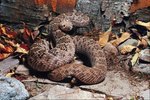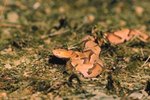
Delaware is home to about 18 snake species and subspecies. The northern copperhead and the timber rattlesnake are Delaware's only venomous snakes. Both species are pit vipers. Copperheads are frequently misidentified as nonvenomous milk snakes because they look alike. Besides being interesting, snake identification is a useful tool for hikers and outdoors enthusiasts.
The Northern Copperhead
The northern copperhead has a triangular head, a narrow neck, and a 2- to 4-foot-long body that's wide and stout, tapering at the end. He has vertical eye pupils and a pit located behind each nostril. A slender dark line on each side of his face runs through his eyes. He ranges in color from pink to bright orange, with dark, hourglass-shaped bands; white spots are on his gray and black belly. The single row of scales below his anal plate identifies him as venomous. The copperhead usually vibrates his tail before striking. The northern copperhead prefers rocky, wooded hillsides and wetlands.
The Eastern Milk Snake
Unlike the poisonous northern copperhead he favors, the eastern milk snake has a narrow head and a slender body, reaching 2- to 3- feet long. He has round eye pupils and no pits. The milk snake's coloration is gray to tan, with rows of dark red or brown blotches, not the hourglass-shaped bands of the copperhead. A light-colored Y- or V- shaped marking is on his neck. The eastern milk snake has a white belly sporting a black checkerboard pattern, and a double row of scales below his anal plate.
The Timber Rattlesnake
Often found in forests and rocky areas, the thick-bodied timber rattlesnake has a broad, triangular head with a pit located on each side, and vertical eye pupils. His body is rough-scaled and may be dark-colored with dark bands, or light yellow with dark brown or black bands. Like the copperhead, the rattlesnake has a single row of scales below his anal plate. The timber rattler shakes a rattle on the end of his tail and makes a buzzing or rattling sound when he's disturbed.
Identification Clues
Differences between some species of snakes can be difficult to discern. Carefully observe body and head shape, colors, patterns, scale texture, tail-end details, habitat and behavior when identifying snakes. A good example of identifying behaviors is seen in the eastern hognose snake. He hisses and spreads his head and neck to frighten you, then falls over and plays dead.
References
Resources
Photo Credits
-
Jupiterimages/Photos.com/Getty Images
Writer Bio
Karen Mihaylo has been a writer since 2009. She has been a professional dog groomer since 1982 and is certified in canine massage therapy. Mihaylo holds an associate degree in human services from Delaware Technical and Community College.



